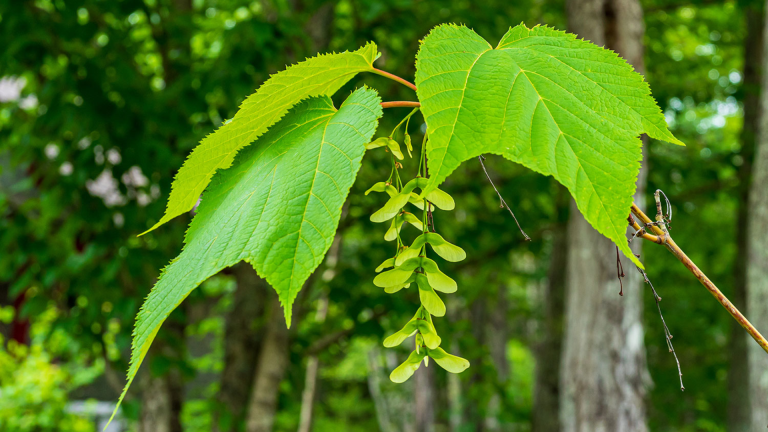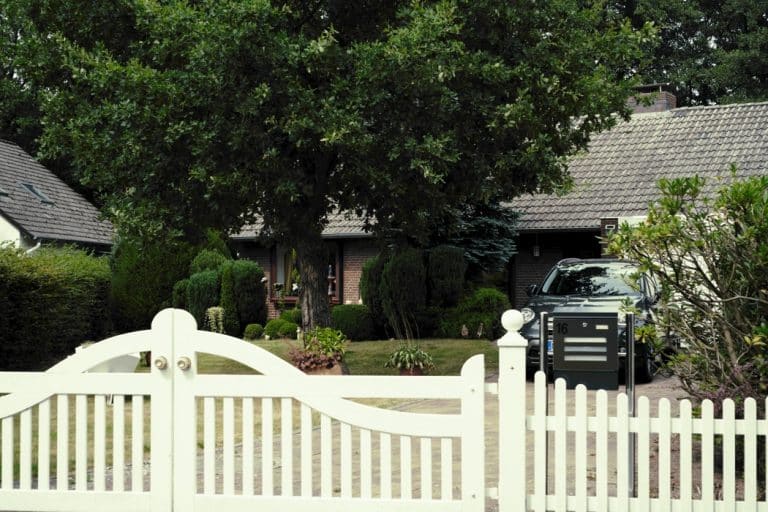The Moosewood tree (also called striped maple or Acer pensylvanicum) is a small, lovely tree that stands out in North American woodlands. With its green and white striped bark and broad leaves, this tree brings quiet beauty to shady spots where other trees might struggle.
In this blog, you’ll learn everything about growing and caring for Moosewood trees – from planting to maintenance. If you’ve been looking for a tree that works well in partly shaded areas or want to add something special to your woodland garden, the Moosewood is an excellent choice.
As a certified arborist with years of experience growing native trees, I’ve helped hundreds of gardeners successfully add these trees to their landscapes. The Moosewood offers food for wildlife, interesting bark patterns year-round, and thrives in spots where many trees fail.
What Exactly Is a Moosewood Tree?
Moosewood trees are small, understated beauties of the forest. I often find them reaching heights of 15 to 25 feet when fully grown. You might also know them as striped maple or by their scientific name, Acer pensylvanicum.
The most noticeable feature? Their distinctive bark. It’s smooth with clear green and white stripes running vertically along the trunk. These stripes stand out especially well during winter months when leaves have fallen.
The leaves are large—about 5 to 8 inches across—with three pointed lobes and finely toothed edges. In fall, they turn a soft yellow color.
Want to find one in the wild? Look in the eastern United States and southeastern Canada. They grow naturally from Nova Scotia down to Georgia, mainly in hardiness zones 3 through 7.
How can you spot a Moosewood?
- Look for those green-white striped stems
- Check for large, three-lobed leaves
- Find them in the understory of forests
- Notice they’re smaller than many other maples
These trees prefer cool, moist, shaded areas. You’ll often find them hanging out beneath taller trees, not fighting for the spotlight.
In your yard, they make perfect additions to woodland gardens or shady spots where other trees might struggle. Their modest size means they fit well in smaller spaces, too.
Growth Habits and Lifecycle of Moosewood
Moosewood trees grow at a steady, modest pace. I’ve watched them add about 1 to 2 feet of height each year in good conditions. You can expect your tree to reach its full height of 15 to 25 feet in about 10 to 15 years. Width-wise, they spread 15 to 20 feet at maturity.
These trees change their look with each season.
- Spring brings new life. Fresh, light green leaves unfold from their buds. Small, drooping yellowish-green flower clusters appear, typically in May or early June. These flowers hang in groups of 3 to 4 inches long.
- Summer showcases the full leaf display. The large, three-lobed leaves create nice shade patches underneath. Their striped bark remains visible and interesting.
- Fall offers subtle color changes. Unlike their bright red maple cousins, Moosewood leaves turn a gentle yellow before dropping.
- Winter reveals the bare structure. This is when the green and white bark really stands out in the landscape. I find this to be their most eye-catching season.
The fruits form after flowering as paired winged seeds (called samaras). These hang in clusters and mature by late summer, then scatter with the wind. Moosewood trees typically live 50 to 100 years in good conditions.
They don’t usually face major disease issues, which helps with their longevity. In forest settings, these trees often form multiple trunks. If you prefer a single trunk for your yard, some light pruning when young will guide their growth pattern.
Best Conditions for Planting Moosewood
1. Soil Needs
I’ve found that Moosewood trees thrive in specific soil conditions. They prefer moist, well-draining soil that’s rich in organic matter. You’ll have the best results with slightly acidic soil (pH 5.5 to 6.5).
Adding a layer of compost or leaf mulch helps create the woodland-like conditions these trees love. The extra organic matter keeps the soil cool and damp, much like their natural forest home.
These trees don’t do well in dry or compacted soil. I’ve seen them struggle in clay-heavy areas unless the soil is first improved with organic amendments.
2. Light Requirements
Moosewood trees are shade-lovers at heart. They grow naturally as understory trees beneath taller forest canopies. You’ll want to place them in partial to full shade for best results.
Too much direct sunlight can damage their leaves and slow their growth. I’ve noticed that morning sun with afternoon shade works very well for these trees in home landscapes.
If you plant them in too sunny a spot, their leaves might develop brown, crispy edges during summer heat.
3. Ideal Planting Locations
The north or east side of your house often provides perfect conditions. These areas typically offer the right amount of shelter and shade.
Woodland edges make excellent spots for Moosewood trees. You can use them as transition plants between your lawn and wilder areas of your property.
I like to place them where their unique striped bark can be easily seen, especially during winter months. Being near a window or along a walking path lets you enjoy this feature up close.
4. Companion Plants
Pair your Moosewood with other shade-loving woodland plants for a natural look. Ferns create a lovely ground layer beneath these trees.
Native wildflowers like trillium, jack-in-the-pulpit, and bloodroot grow well in similar conditions. You can plant these around the base of your Moosewood.
Shade-tolerant shrubs such as spicebush or winterberry holly make good neighbors, too. I’ve created beautiful woodland gardens using these combinations.
Caring for Your Moosewood
1. Watering Needs
New Moosewood trees need regular watering during their first two years. I make sure to give them a good soaking once a week when there’s no rain. You should aim for about 1 inch of water each time, wetting the soil to a depth of 6-8 inches. Once established, these trees become much more self-sufficient.
They’ll mainly need extra water during long dry spells or summer heat waves. I’ve found that slow, deep watering is better than frequent light sprinkling. Watch the leaves for signs of water stress. If they start to droop or curl at the edges, your tree is telling you it needs a drink.
2. Mulching and Feeding
Moosewood trees benefit greatly from a 2-3 inch layer of mulch spread around their base. I use shredded leaves, pine straw, or wood chips to mimic their natural forest floor setting. You should keep the mulch a few inches away from the trunk to prevent rot issues.
These trees rarely need extra fertilizer if planted in decent soil. If your tree looks pale or grows slowly, you might add a light application of balanced, slow-release fertilizer in early spring. I’ve found that a yearly top-up of fresh compost or leaf mulch provides all the nutrients most Moosewood trees need.
3. Pruning Guidelines
Moosewood trees need very little pruning. Their natural shape is part of their beauty. You should only remove dead, damaged, or crossing branches when needed. If you want to shape your tree slightly, winter or early spring is the best time to prune.
I avoid pruning in late spring when the sap is flowing, as maples can “bleed” sap from cuts during this time. For a more tree-like form, you might remove lower branches gradually as the tree grows. If you prefer the multi-stemmed look, simply let the tree grow naturally.
4. Pest and Disease Management
Moosewood trees face few serious problems. Occasionally, they might get aphids or scale insects on their leaves. You can usually wash these off with a strong spray of water from your hose. Verticillium wilt can affect maples, showing up as sudden wilting or death of branches.
I remove any affected branches right away if I spot this issue. In wet conditions, keep an eye out for fungal leaf spots. These rarely harm the tree long-term, and fallen leaves should be cleaned up in fall to reduce future problems.
Benefits of Growing Moosewood
Moosewood trees, also known as Striped Maple (Acer pensylvanicum), offer many good points for home gardens and landscapes. These trees aren’t just nice to look at—they bring real value to your yard.
1. Wildlife Support
Moosewood trees serve as mini wildlife havens in your yard. I’ve watched countless birds use them for nesting and shelter. You’ll notice chickadees, nuthatches, and warblers visiting regularly.
The seeds attract small mammals like chipmunks and mice. These creatures help spread the seeds to new areas, supporting future tree growth.
Moose and deer sometimes browse on the twigs and leaves, which explains the “moosewood” name. Various insects feed on the leaves without causing serious harm to the tree, and these insects become food for birds. Native pollinator insects visit the spring flowers, making these trees part of your local food web.
2. Year-Round Visual Appeal
The striped bark of Moosewood trees provides interest in every season. I find it especially striking in winter against snow or when wet from rain. You can enjoy this feature whether leaves are present or not.
Fall brings a gentle yellow leaf color. While not as bright as sugar maples, the soft gold tones add a warm glow to shady areas where other trees might not show much fall color.
The large, three-lobed leaves create interesting patterns of light and shadow throughout summer. Their size and shape stand out compared to other small trees. Spring shows off the hanging yellowish flower clusters, adding another season of interest to your landscape.
3. Woodland Restoration
Adding Moosewood trees helps rebuild natural forest layers. I’ve used them in restoration projects with great success. You can create more complex and healthy ecosystems by including understory trees like this one.
These trees grow well beneath taller species, filling in the middle layer of woodland structure. This layering provides more habitat options for wildlife.
Their leaf litter breaks down to feed the soil, just as it would in a natural forest. The decomposing leaves help build rich, healthy soil over time. By planting native trees like Moosewood, you’re helping preserve the genetic diversity of local plant populations.
4. Perfect for Problem Spots
Moosewood trees thrive in shady areas where many other trees fail. I’ve planted them successfully in spots that seemed impossible to landscape. You can turn those dark corners of your yard into green spaces.
They need minimal care once established. This makes them perfect for busy homeowners or natural-style gardens. Their smaller size fits well in modern yards with limited space. No massive roots or towering heights to worry about.
Since they evolved locally, they typically handle regional weather patterns, pests, and diseases without special attention.
Fun Facts and Historical Uses
1. Interesting Names
The Moosewood tree has collected several nicknames over the years. People call it “goosefoot maple” because its leaves resemble the shape of a goose’s foot. I’ve always thought this was a fitting description. You can see the resemblance when you hold a leaf by its stem.
Whistlewood is a less common but beautiful nickname. Early settlers noticed the straight young branches could be hollowed out to make simple whistles and flutes.
2. Traditional and Historical Uses
Indigenous peoples found several uses for this modest tree. I’ve read accounts of various tribes using the inner bark to treat coughs, colds, and lung issues. You might be surprised to learn they also made a spring tonic tea from the bark.
Some Native American tribes used the sap similar to sugar maple, though in smaller amounts. The striped bark served as a trail marker that stood out in dense forests.
3. Forest Ecology Role
Moosewood trees fill an important middle layer in the forest structure. I’ve observed how they thrive in the dappled light beneath taller trees. You can think of forests as having layers, like an apartment building, with different species living at different heights.
They serve as “nurse trees” in forest recovery. After disturbances like storms or fires, these trees help rebuild the forest by growing in partial shade where other trees might struggle.
Conclusion
The Moosewood tree offers quiet beauty without asking for much in return. I’ve grown to appreciate these trees for their modest size, unique striped bark, and ability to thrive in shady spots where options are limited.
By adding a Moosewood to your yard, you’re not just getting a pretty tree—you’re supporting local wildlife and helping rebuild natural forest systems.
These native trees connect your modern landscape to the forests that once covered much more of North America. You’ll find they bring a sense of place and history to your garden. Next time you walk in the eastern woodlands, look for those distinctive green-white stripes on slender trunks.
Or better yet, find a spot in your yard with dappled shade and good soil, and plant one of your own. Your efforts will be rewarded with a faithful, low-maintenance tree that gets more interesting each year.

















